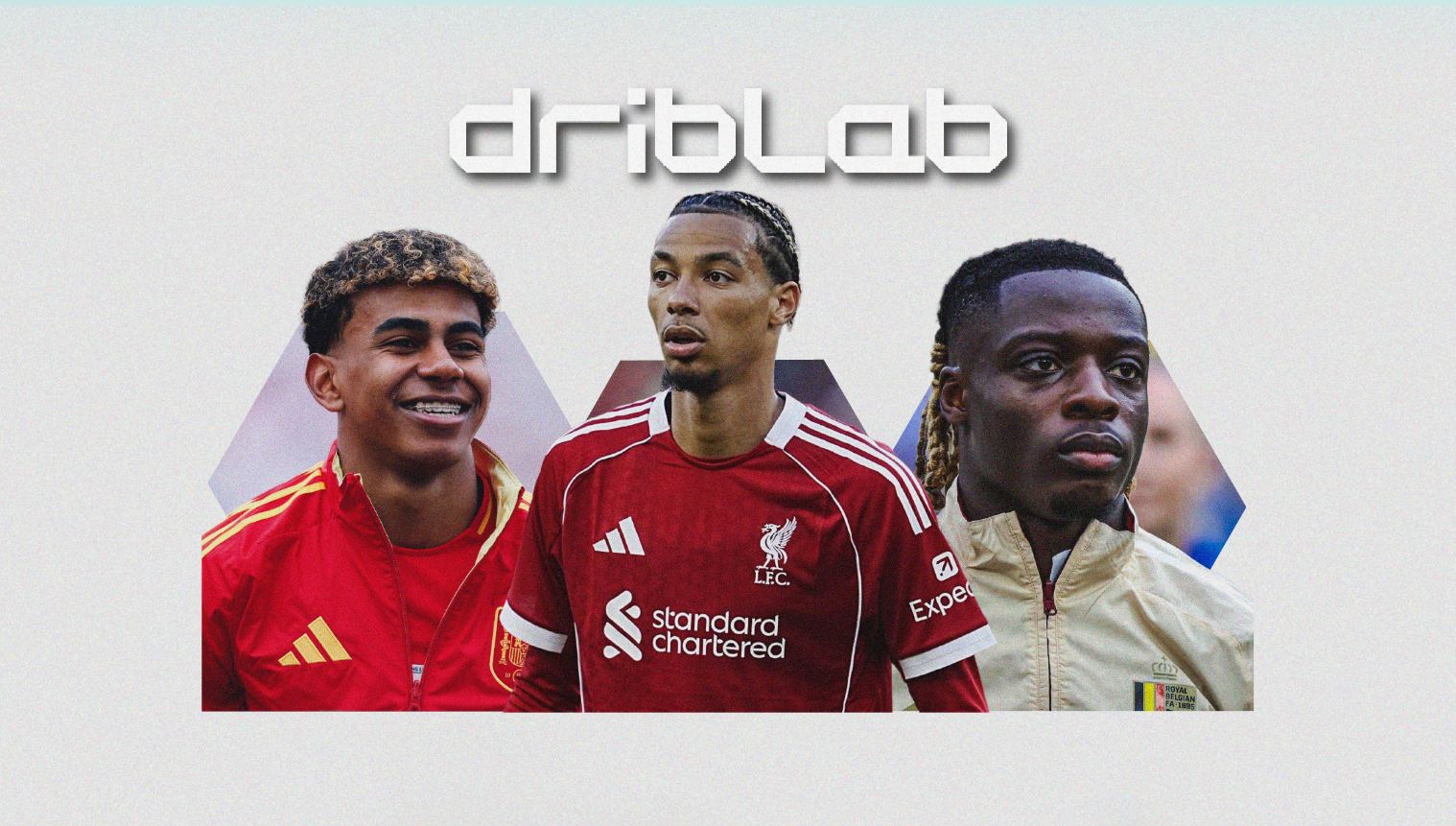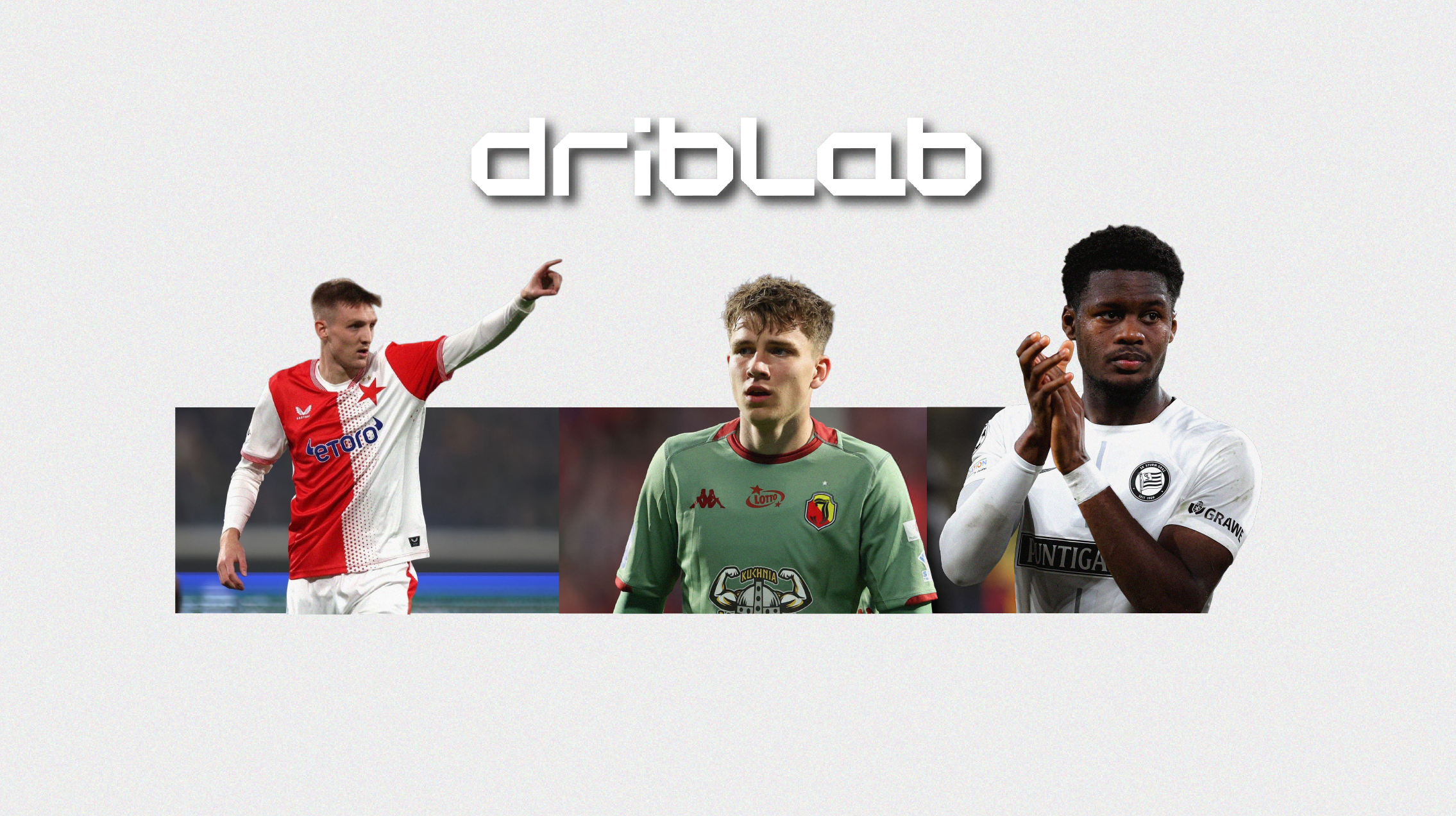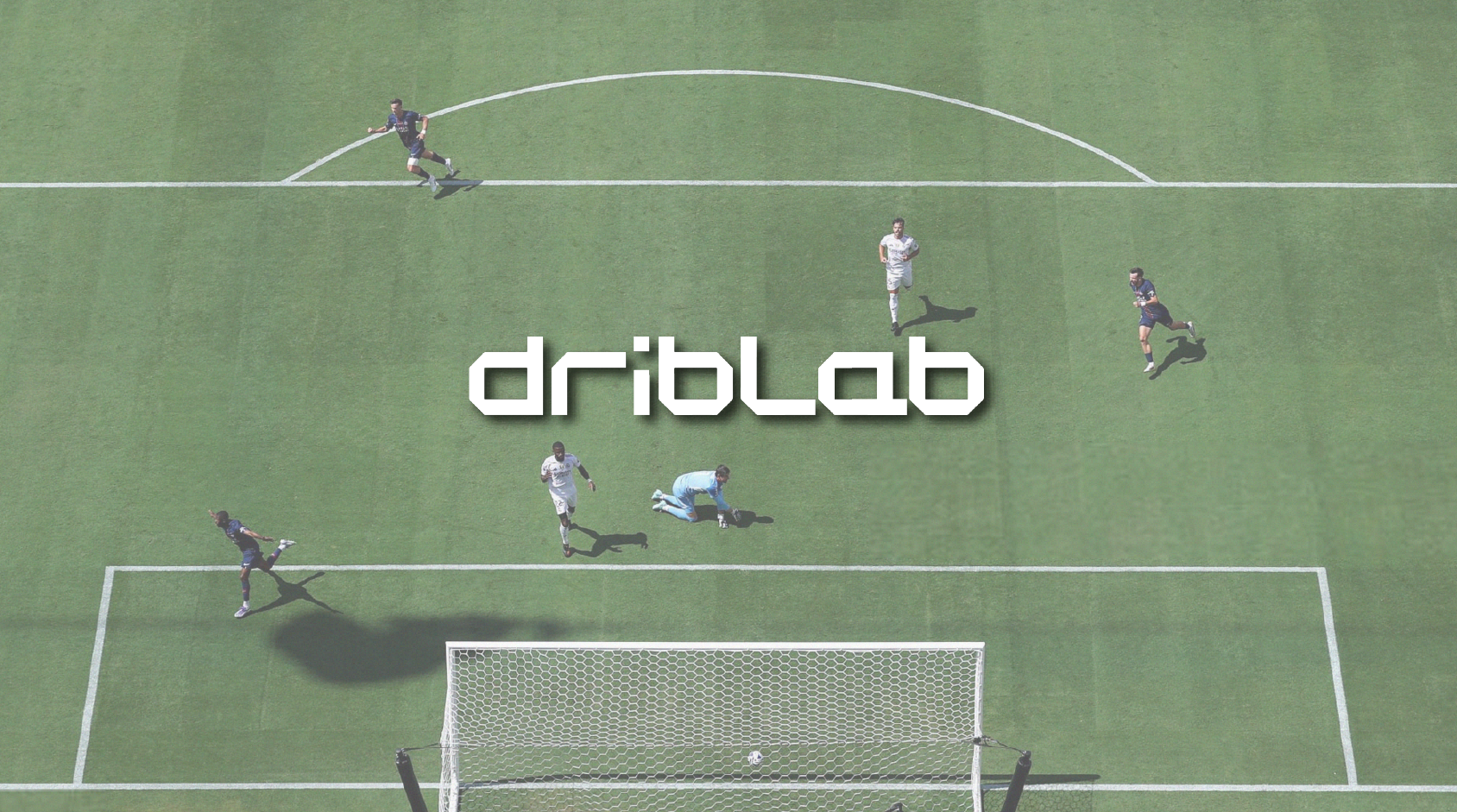Dribbling is one of the most decisive elements in football. It can change the whole picture of a game. Dribbling shifts everything. It can turn the dominated into the dominant.
A dribble is not an end in itself but a means to achieve an objective. Dribbling helps you escape pressure, and can also create the perfect platform to assist or shoot. A wide range of possibilities can emerge after a dribble. Today, we'll focus on two of them: we want to identify the players who dribble to shoot, and those who dribble with the intention of dribbling again — and understand what they are trying to achieve by doing so.
DRIBBLE: THE PRELUDE TO A SHOT
We asked our database which players recorded the most combined dribble-and-shot actions during last season across the top five European leagues. We are only counting those actions where the shot happened within one second of the dribble being completed.
This won’t surprise anyone: the top two players on the list were Lamine Yamal (58 dribble-and-shot actions) and Kylian Mbappé (42).
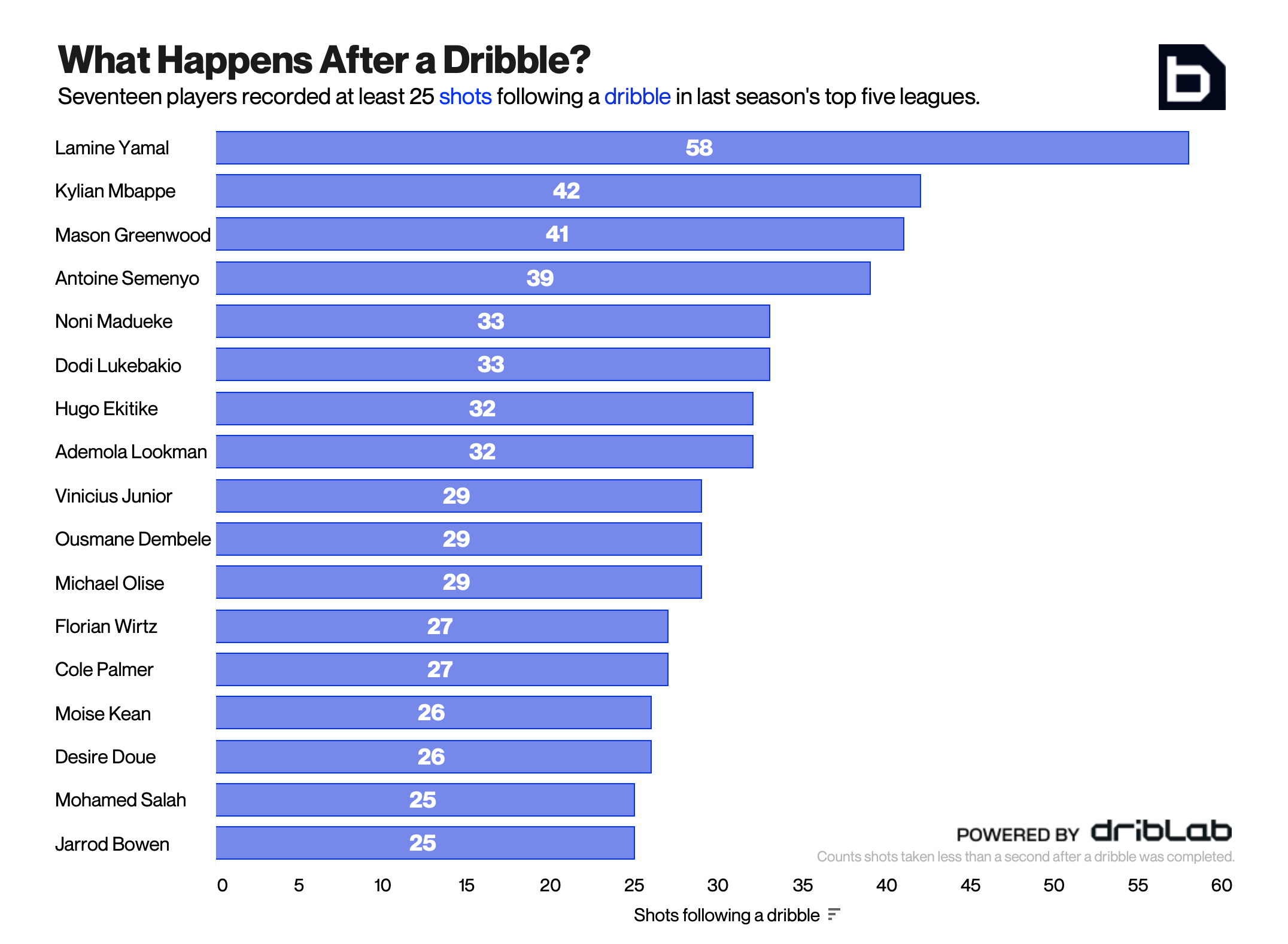
We can learn a few things by just looking at this table. First of all, a huge congratulations to Bournemouth for convincing Antoine Semenyo to put pen to paper on a new contract. Iraola won’t receive better news than this all summer. Last season in the Premier League, only Jeremy Doku (130) completed more last-third dribbles than the Ghanaian (105). As we will see below, Semenyo made into the list of 22 players who most often used their dribbling to create shooting opportunities. In fact, 32% of Semenyo’s total completed dribbles were immediately followed by a shot. He’s firmly in the dribble-to-shoot category.
Another conclusion we can draw from this list is that Sevilla FC will be in massive trouble if they don’t keep hold of Dodi Lukebakio. However, after finishing 16th in LaLiga last season, he’s one of the few assets who could help finance some much-needed summer signings for the Andalusian side.
He was Sevilla’s main attacking outlet in an often unconvincing forward line. He took charge of shooting, dribbling and creating chances. When on the pitch, Lukebakio’s touches in the opposition box accounted for 29.2% of Sevilla’s total touches in that area. Only 5 players registered a higher share in LaLiga and none of them played for Sevilla.
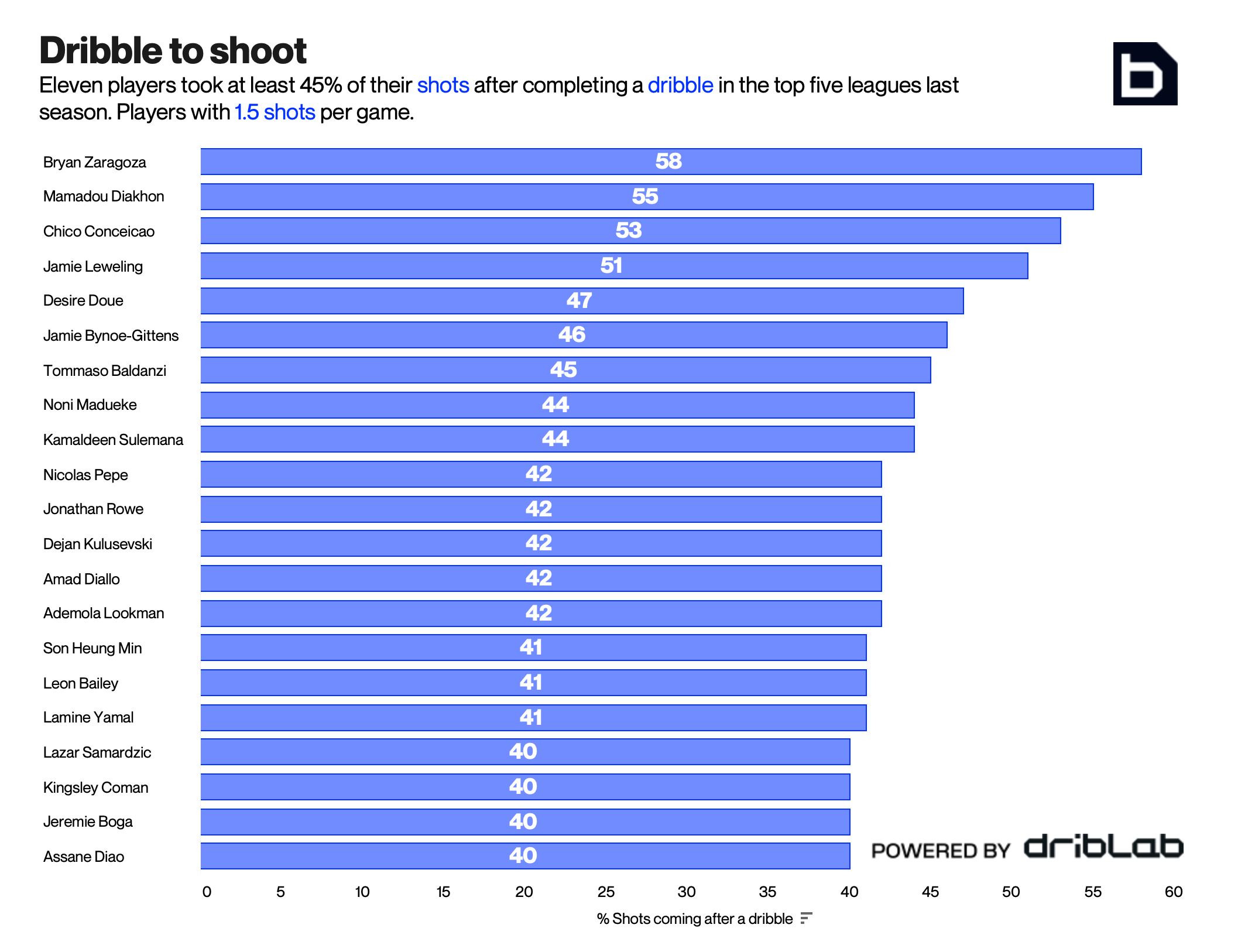
We’ve looked at the raw numbers in terms of combined actions. While there are exceptions, it’s usually the norm that top players from top teams register the highest totals. However, when we switch to the percentage of shots coming immediately after a dribble, the picture changes.
First of all, some uncommon names start to pop up. Bryan Zaragoza is the main surprise here. He registered a season-high 58% of shots coming within a second of him completing a dribble. Zaragoza shows a strong reliance on his dribbling to get shots off — whether due to a limited box movement or being set up by his teammates to take on a defender and shoot. The fact remains that 6 out of every 10 shots taken from Celta’s newest signing came immediately after completing a dribble.
As he approaches his first start for LAFC after leaving Spurs, the latter version of Heung-Min Son fully entered the dribble-to-shoot category. After losing a yard of speed, Son focused on being a pure goalscorer, hence his dribbling numbers were down. In the Premier League 24/25, 29 wide attackers attempted more opposition-half dribbles than Son. However, the Korean still recorded 22 combined actions of dribble-and-shot.
Dribbling clearly plays a major role in shooting. Particularly for players who receive less help from their teams. Mbappé, Lamine Yamal or Dembele are the biggest examples of players who are exceptionally well-supplied by teammates, yet also capable of generating shots on their own.
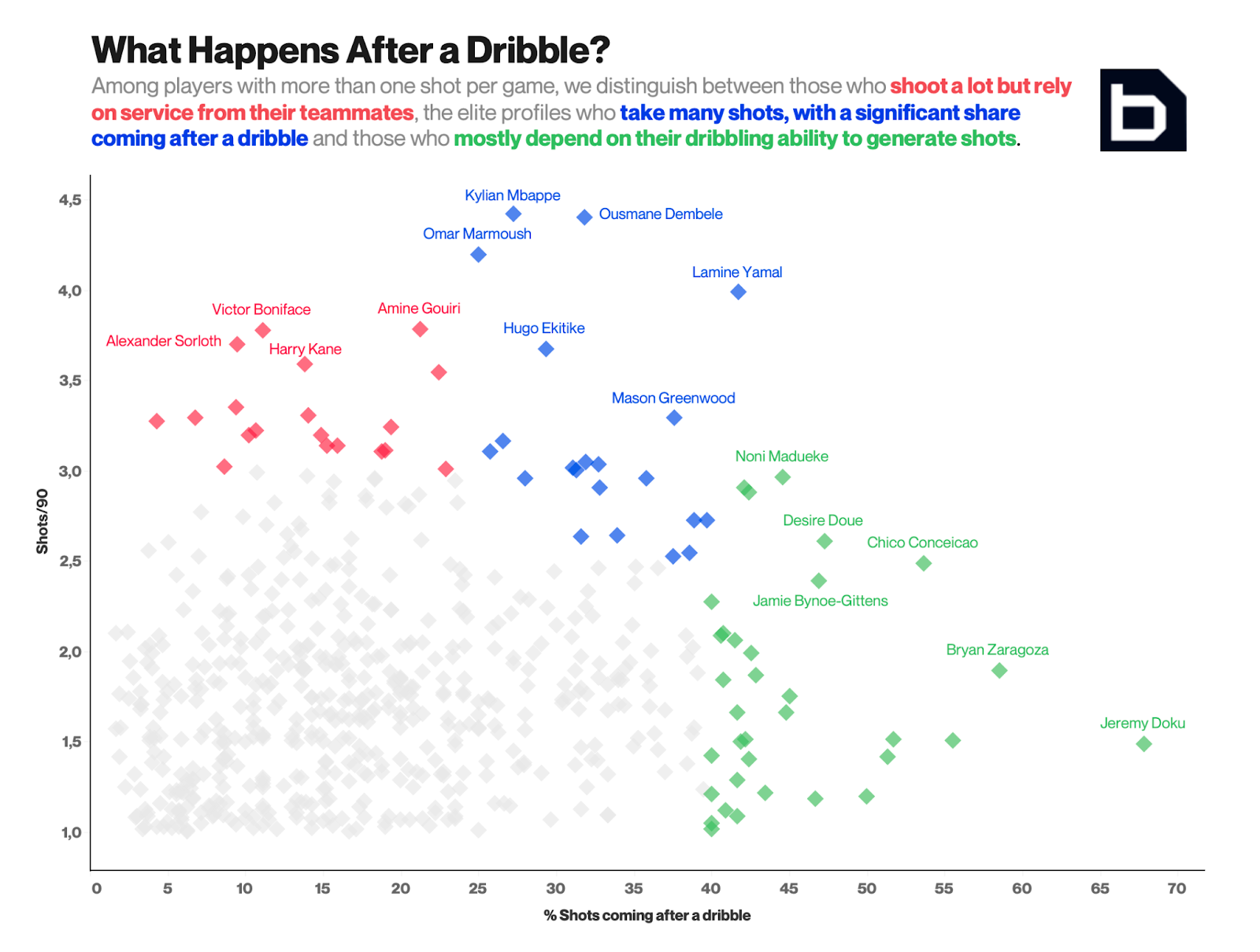
On the other side, there are the high-volume shooters (Sorloth, Kane, Boniface) who rely on other ways to create shooting situations. These players take advantage of qualities such as elite box movement, being physical dominance against defenders or one-touch finishing. They are often strikers who dribble when strictly necessary.
In Robert Lewandowski’s case, 8 out of every 10 dribbles he completed led directly to a shot. No striker in Europe’s top five leagues posted a higher ratio. The Polish forward averaged 0.48 combined dribble-and-shot actions per game and just 0.57 completed dribbles per match — meaning 83% of his dribbles resulted in a shot. On the other hand, only 14% of his shots per game were preceded by a dribble.
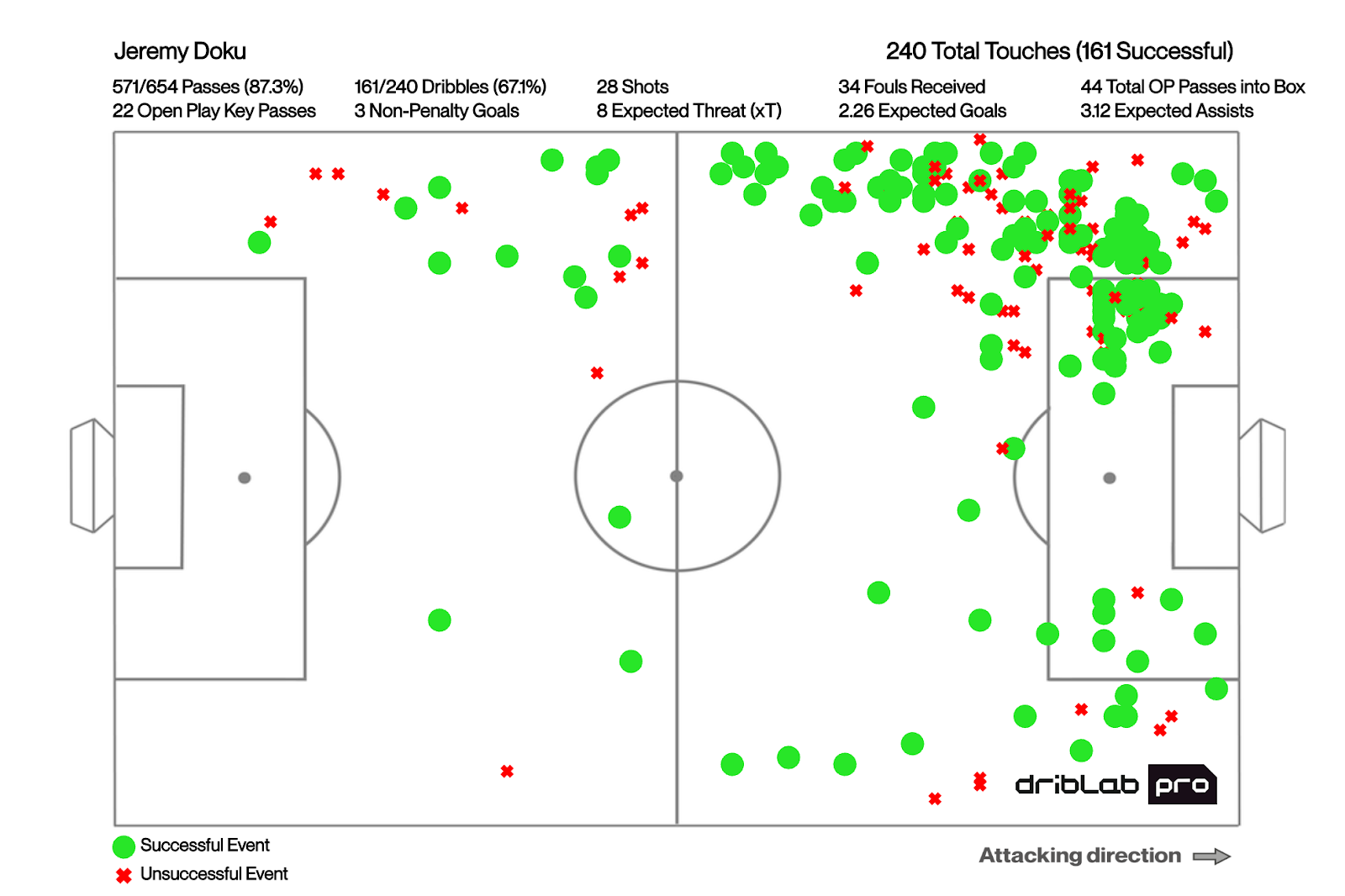
On the other side of the spectrum, we find Jeremy Doku, who didn’t make our % shots-after-a-dribble list due to his low shot volume (we set the minimum at 1.5 shots per game). In his case, Doku took 28 shots all season, 19 of them were preceded by a dribble. That’s a staggering 67% of shots coming after a dribble.
ONE DRIBBLE... AND ANOTHER
Lamine Yamal. Vinicius Junior. If you think of two great dribblers, these are the names that come to mind.
In this case, we extend the time frame to two seconds between dribbles, due to the condition that another defender has to appear to be beaten.
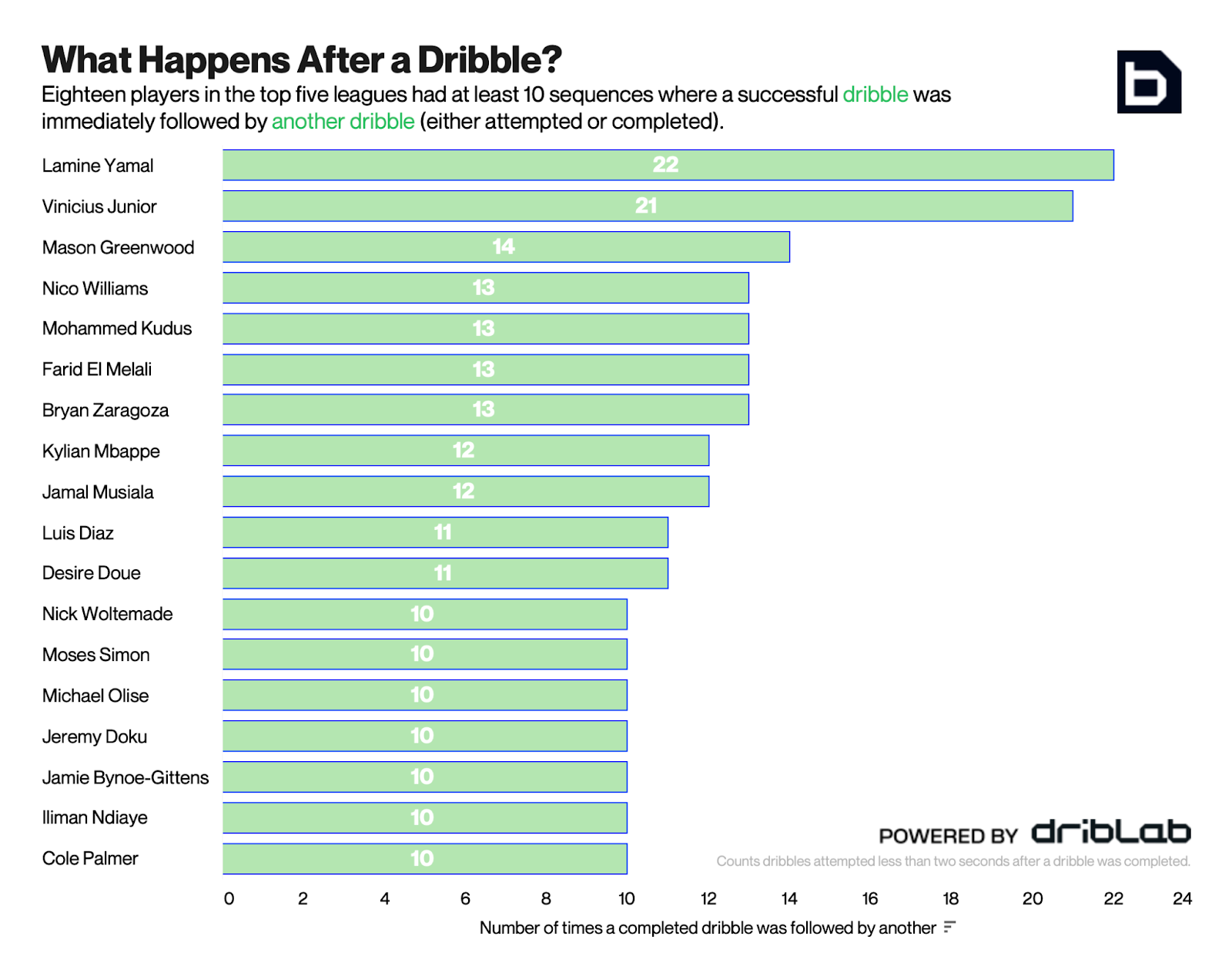
It might be surprising that the Spanish international winger didn’t appear on our combined dribble-and-shot actions list, but the reality is that Nico Williams does everything at Athletic and often doesn’t get to take the final shot. Williams Jr is the second winger who carries the most responsibility in building up xG for his team in LaLiga.
This metric, xG Build-Up, measures how involved a player is in build up in their team. To calculate it, we assign the final xG value of a possession to every player involved—except for those who perform the last two actions. This way, we identify which players participate in the build-up process. In this case, Nico Williams accounts for 15% of Athletic Club’s total build-up value per game.
Additionally, he is responsible for 9% of ball progressions into the final third and 31% of his team’s passes into the box. That’s why he often chains dribble after dribble rather than dribble leading directly to a shot.
Another player who didn’t appear on the dribble-to-shot list is Mo Kudus. The situation with the Ghanaian is similar to Nico Williams’. His team relied on him to help progress the ball out of their own half. Kudus attempted the most dribbles in his own half of any player in the top five European leagues last season (60). Only 28 players tried more than 30 dribbles in their own half, and only three attempted more than 45: Lamine Yamal, Morgan Rogers, and Kudus. Of those 28 players who attempted at least 30 dribbles in their own half, 15 had a better success rate than Kudus.
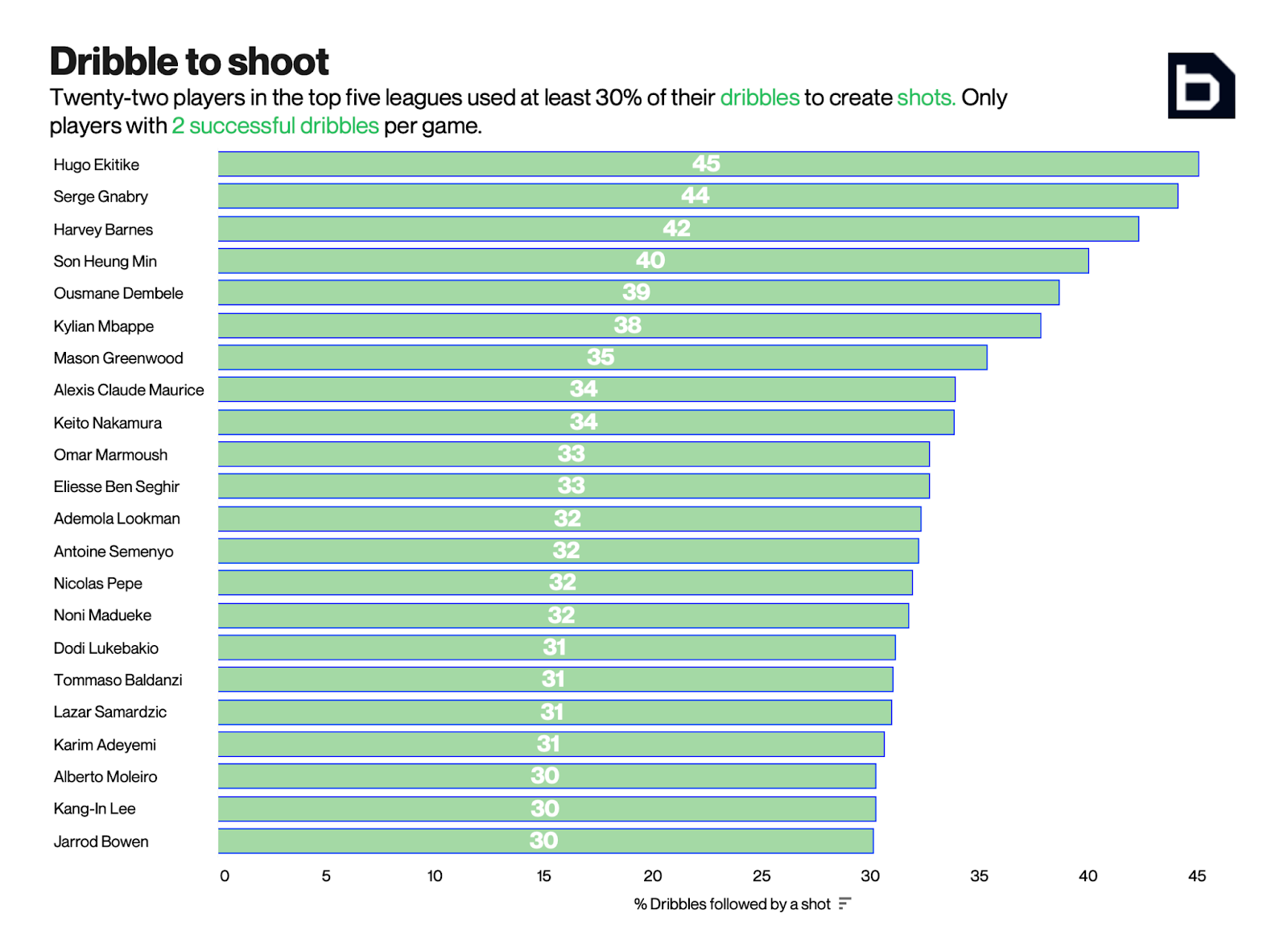
If you remember what we previously said about Semenyo, that 32% of his completed dribbles were followed by a shot, you will easily understand this list. Look at Liverpool’s new recruit Hugo Ekitike: of all players with +2 successful dribbles per game, he used 45% of his dribbles to generate shots.
One player that has been under the radar for long enough now is Keito Nakamura. Even if his game is limited and could probably not escalate to a top team, his 11 non-penalty goals last season were key in achieving Ligue 1 survival with Stade Reims. At the age of 25, he could be a good bench option for a European team who’s looking for a player with end product and dribbling and ball-retention ability.
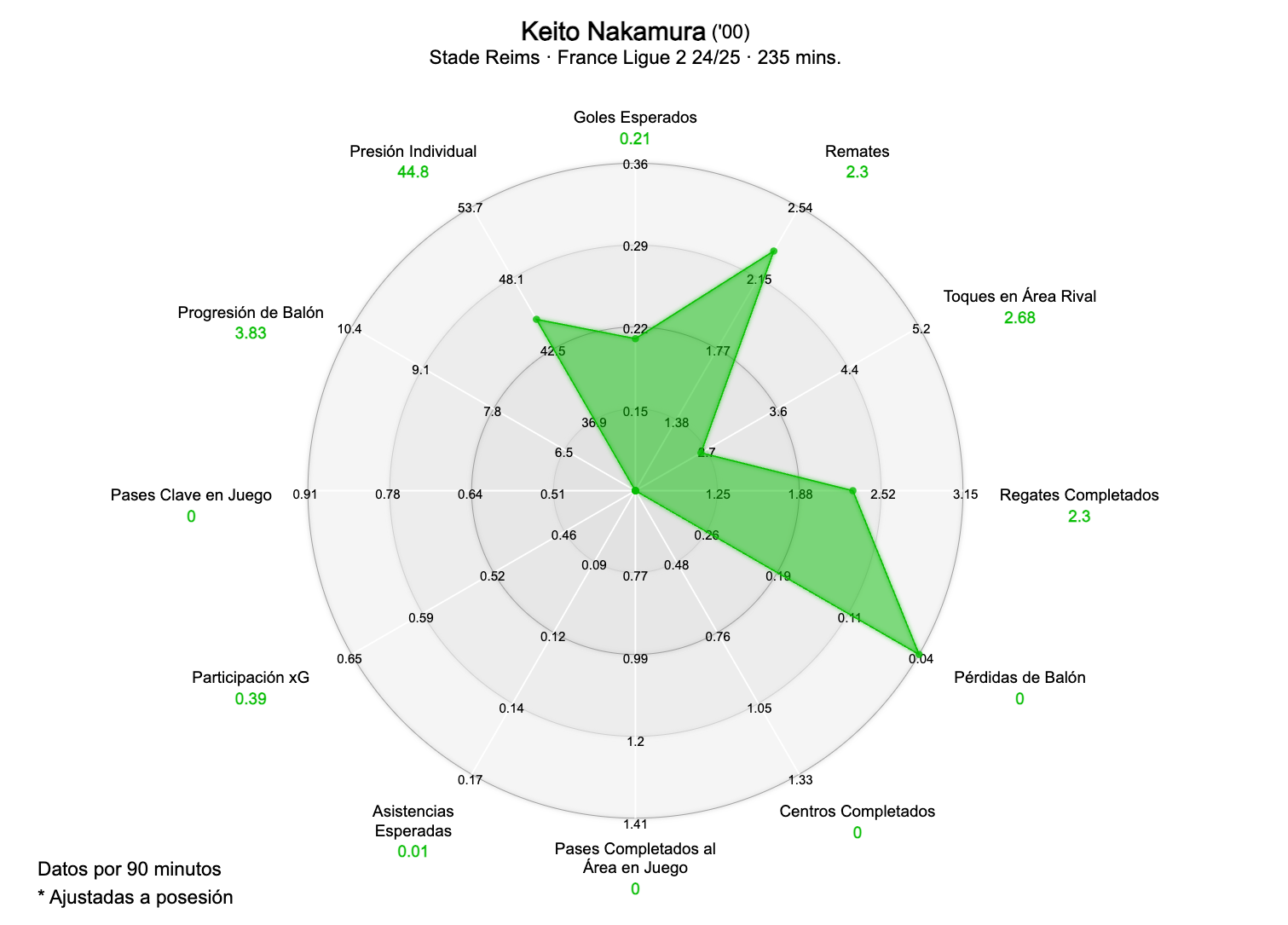
Lastly, we’ve created another scatter plot but this time focusing on those players who combine dribble after dribble. Players like Michael Olise or Savinho rarely link combined dribbling actions. They often look to dribble, pass and move to receive again. They’re primarily collective players.
The case of Doku is difficult to explain. His share of dribble-after-dribble actions is low due to a season-high average of 8.5 successful dribbles per game. For another player, that same share of dribble-after-dribble actions would be sky high.
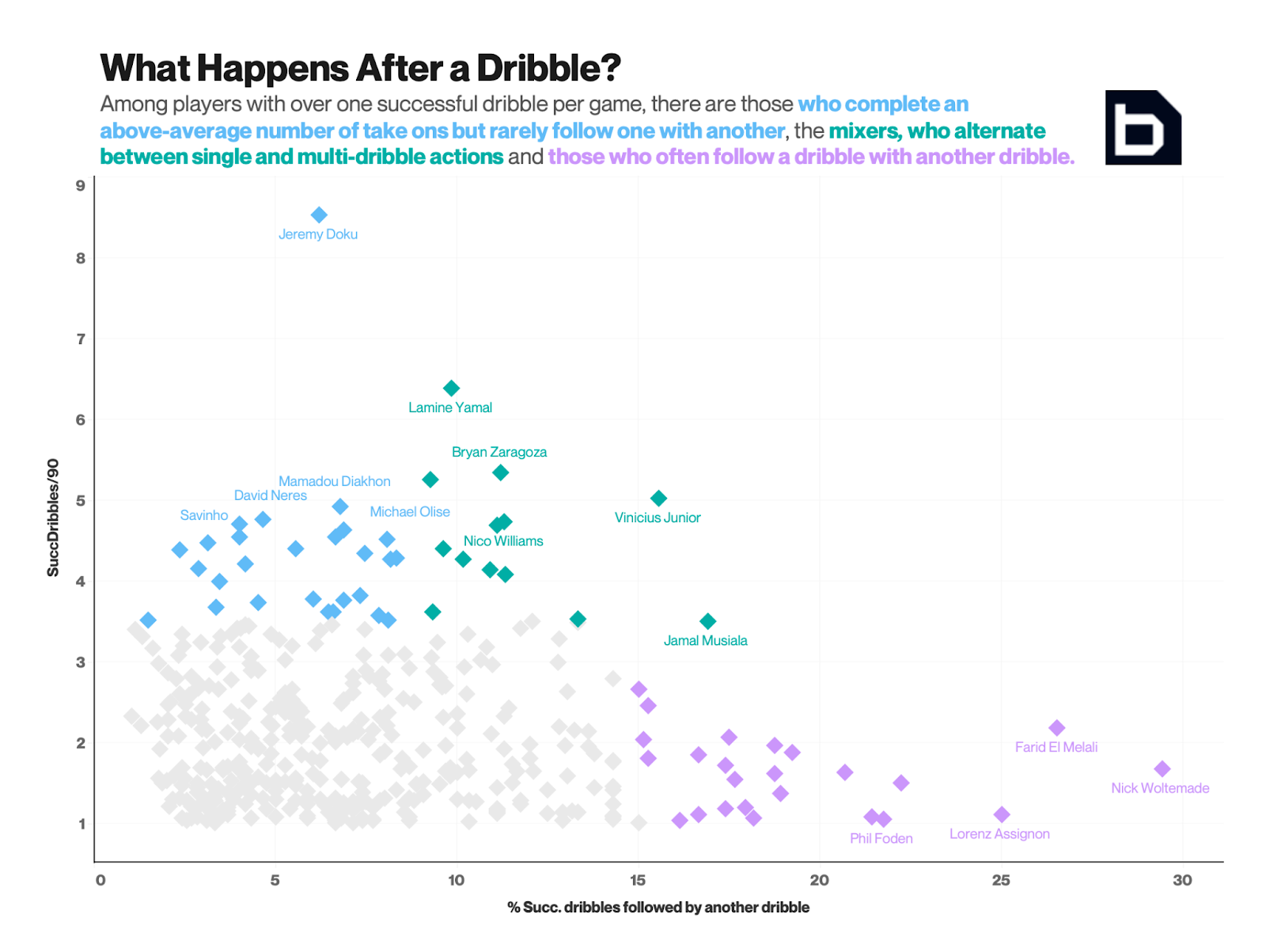
At the other end of the spectrum, we have the unusual case of Nick Woltemade, who doesn’t dribble much but tends to do so in chains. He’s accompanied by Lorenz Assignon, a full-back with huge stamina; Farid El Melali, the Angers winger who is currently without a club; and Phil Foden, who averages 1.06 dribbles per game and often strings together dribble-after-dribble actions almost by instinct.
With our data, you can identify many of these combined actions — not only involving dribbles, but a wide range of other possibilities. Today, we’ve chosen to focus on dribbling, one of football’s most beautiful yet important actions, but with Driblab you can explore any you like.
